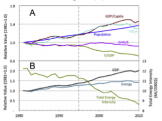Between 1995 and 2010, the total energy intensity (E/GDP, PJ/Gross Domestic Product in 2002$) of the Canadian economy declined by 23% or −2.64 MJ/$. To understand why, the Logarithmic Mean Divisia Index (LMD-I) method was used to decompose a large body of government statistical data supporting the observed E/GDP de- cline. The analysis shows that (a) 48% (1.27 MJ/$) of the decline was associated with an inter-sector structural change in the economy (i.e. an increased contribution to the total GDP of the low energy-using commercial and institutional sector compared with the high energy-using manufacturing and heavy industry sectors); (b) 24% (0.62 MJ/$) was attributed to the impact of the Canadian GDP growing faster than population; (c) 22% (0.58 MJ/$) of the decline was associated with an overall decrease in business energy intensity. A deeper analysis of business sectors shows a positive impact of 0.4 MJ/$ from increased energy intensity in the oil and gas sector, offset by a 0.98 MJ/$ decline due to energy intensity declines in the other business sectors; (d) 6.3% (0.17 MJ/$) of the decline was associated with an improvement in the energy intensity of households, mostly from residential energy use rather than personal transportation energy use. These results provide insights for policy makers re- garding those aspects of the Canadian economy that contribute to, or work against, efforts to transform energy systems toward sustainability.

